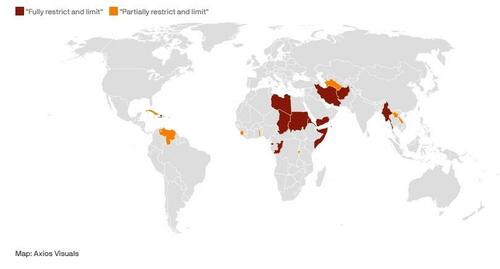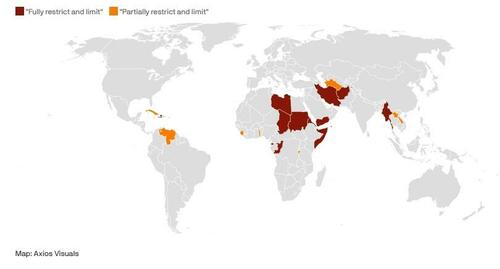
Having previously hinted he might crack down on foreign visitors, late on Wednesday President Trump signed a proclamation banning nationals from 12 countries from traveling to the US, and introduced travel restrictions on seven others, reintroducing a controversial immigration policy that came to define the early days of his first term.
The ban will completely bar travel to the U.S. by citizens of the following countries: Afghanistan, Myanmar (formerly Burma), Chad, The Republic of the Congo, Equatorial Guinea, Eritrea, Haiti, Iran, Libya, Somalia, Sudan and Yemen. Citizens from an additional list of countries will be barred from permanently immigrating to the U.S., along with applying for tourist or student visas; those countries are Burundi, Cuba, Laos, Sierra Leone, Togo, Turkmenistan, and Venezuela. Citizens from these seven countries will still be eligible for other temporary visas, such as the H-1B or other temporary work visas.
The ban only applies to people currently outside the U.S., though anyone currently in the U.S. who leaves could get stuck abroad as a result of it. It also excludes any nationals of these countries who hold green cards, along with anyone traveling to the US for coming major sporting events, including the World Cup in 2026 and the Olympics in 2028. Afghans who receive special immigrant visas, a special visa reserved for Afghans who worked alongside the U.S. military during its two-decade presence in Afghanistan, are also exempt.
The administration justified the restrictions in a number of ways. Several of the countries, it said, had unacceptably high temporary visa overstay rates, necessitating a ban. Others, it said, couldn’t be relied upon to issue valid passports to verify a person’s identity. Haiti, the only country in the Western Hemisphere to face a complete ban, was included because “hundreds of thousands of illegal Haitian aliens flooded into the U.S. during the Biden administration,” the White House said.
That said, today’s decision is hardly a surprise: Trump repeatedly promised during the campaign that, if re-elected, he would bring back an expanded version of his first travel ban, though the issuance of the ban took months longer than expected. In anticipation, numerous universities and businesses advised their students and employees to remain in the country after Trump’s inauguration to avoid being ensnared.
Citizens of many of the countries on the final list have been on high alert for months, after earlier lists circulated in several media reports. It isn’t likely, then, that the new ban would create scenes of chaos at airports across the country, as the first travel ban did when Trump signed it in a surprise move a week after taking office.
After several years of litigation, the Supreme Court in 2018 upheld the legality of Trump’s travel ban, so long as the administration could articulate a rationale for why countries are included. That will make it tougher for immigration advocates to challenge this new ban. Still, it isn’t clear how the administration included certain countries when others that meet similar criteria were left off the list.
Tyler Durden
Wed, 06/04/2025 – 23:00
